What Does It Mean to See Ourselves in the Finest of Garbs?
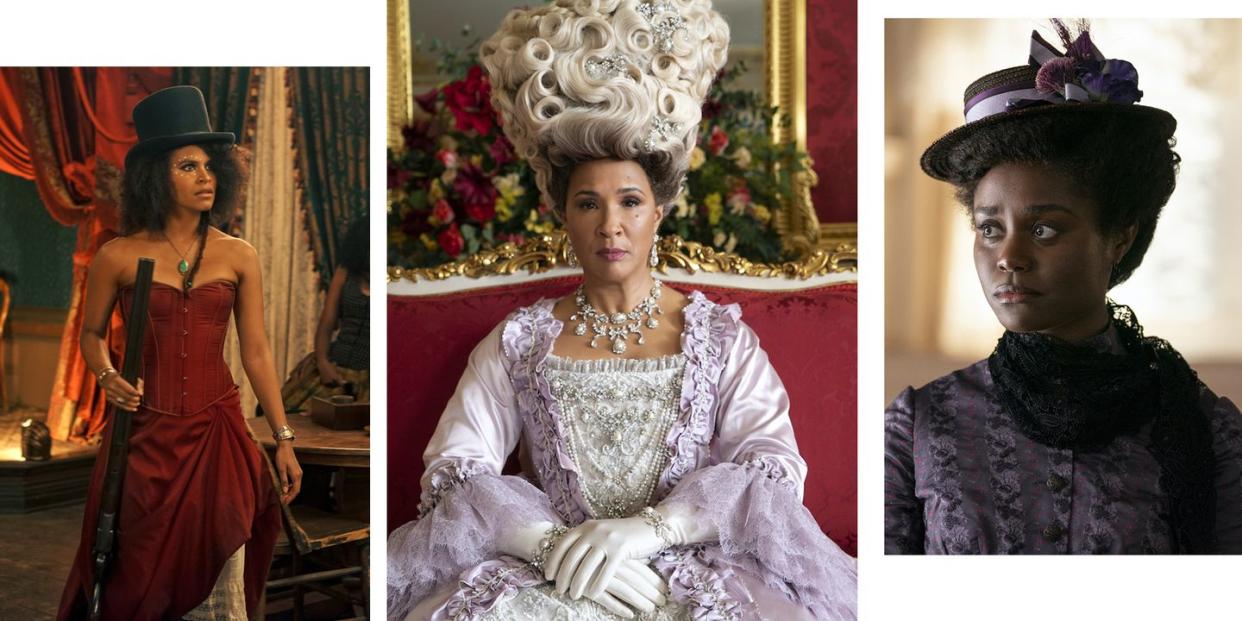
- Oops!Something went wrong.Please try again later.
- Oops!Something went wrong.Please try again later.
When Hollywood tells stories set in the past, racial diversity is often stripped from the tale. And even when Brown and Black characters do appear in period pieces, they’re often shown in subordinate roles to the starring white characters. Representation doesn’t mean everything; often, it is used to avoid doing the harder work of truly reckoning with all the ways in which oppression is woven into the foundations of our world. But there are still times when seeing yourself in stories from which you are generally excluded can feel like a shaft of light cutting through a forest of indifference.
A handful of recent shows and movies like last year’s The Harder They Fall, this year’s The Gilded Age, and Bridgerton (which became a sensation when Season 1 dropped on Christmas Day 2020, and whose second season premiered late last month) place characters of color in the spotlight—and in beautiful, elaborate, sumptuous period costumes. The success of these shows proves there is a desire from audiences to reimagine our fantasies in a way that actually reflects the world we live in. And it forces us to ask the question: What does it mean to see ourselves in the finest of garbs?
Bridgerton, The Gilded Age, and The Harder They Fall all take place in the 19th century, but they do so in different regions, play with varied genres, and range in tone from the grounded to the more stylistic and fantastical. As a result, their costume designers took very different approaches as they researched the periods and settings in which these stories take place.
Bridgerton transports us across the Atlantic to a version of Regency-era England that is a fair bit more imagined than the real early 1800s, a dreamlike element that allows for vibrantly colored and sparkling costumes. Although the story indulges our desire for fantasy, the fact that the world it depicts is populated with a number of non-white faces isn’t without historical basis. “There were Africans present at the royal courts of Henry VII, Henry VIII, Elizabeth I and James I … and across England from Hull to Truro,” historian Miranda Kaufmann writes in Black Tudors: The Untold Story. With the exception of Amma Asante’s Belle in 2013, audiences have rarely gotten to see people of color in prominent period roles.
The Netflix series takes us into the kind of Regency romance that is often associated with the works of Jane Austen—a world dominated by manners and ambition and the way those two aspects collide in the search for a love match. But the world of the show is based primarily in the glittery halls and balls of London, as opposed to the primarily pastoral settings of Austen’s narratives. (One exception: an interlude this season set at Aubrey Hall, the country seat of the Bridgerton family.) The city setting amps up the glamour and, in some ways, raises the stakes both for the characters and the viewers. This shift of venue can be seen in the clothes, which include a slew of cinched corsets, voluminous ball gowns, satin gloves, and decadent jewels.
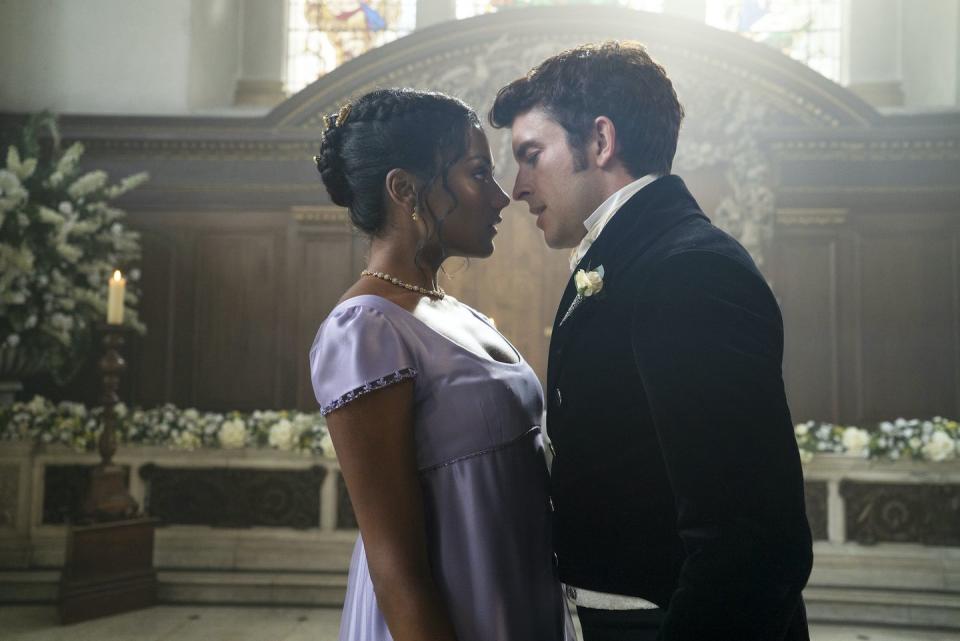
Costume designer Sophie Canale tells BAZAAR.com that the costume department would generally “source through museums, but having to work during a pandemic this season [they] were kind of unable to visit research centers … so [sourcing] was generally through the Internet and books.” This research gave Canale and her team a historical grounding that she built on with more creative elements: “Bridgerton is this amazing world that has been created, so it’s taking fashion references and being able to put them on anyone.” For that reason, we saw many of the characters of color, from dressmaker Genevieve Delacroix to the audience’s favorite, the Duke of Hastings, dressed according to their class and not necessarily their ethnicity.
The introduction of the Sharma sisters in Season 2 has allowed for more of a nod to race and culture. “Having come from India, we used elements of the cut of that culture’s dresses. [We were] still using the empire line, [but] rather than having a center front opening of a regency dress … I’d push the side openings, so you … have this slight nod to the sari.” In a show where jewels play an important role, Canale made sure to put the sisters in Indian jewelry, such as the bracelets the eldest Kate (Simone Ashley) wears in one pivotal scene. “Jewelry is something that’s traveled down generations. They’re heirlooms that people keep hold of, so having the jewelry as a really strong Indian influence was something really important to me.”
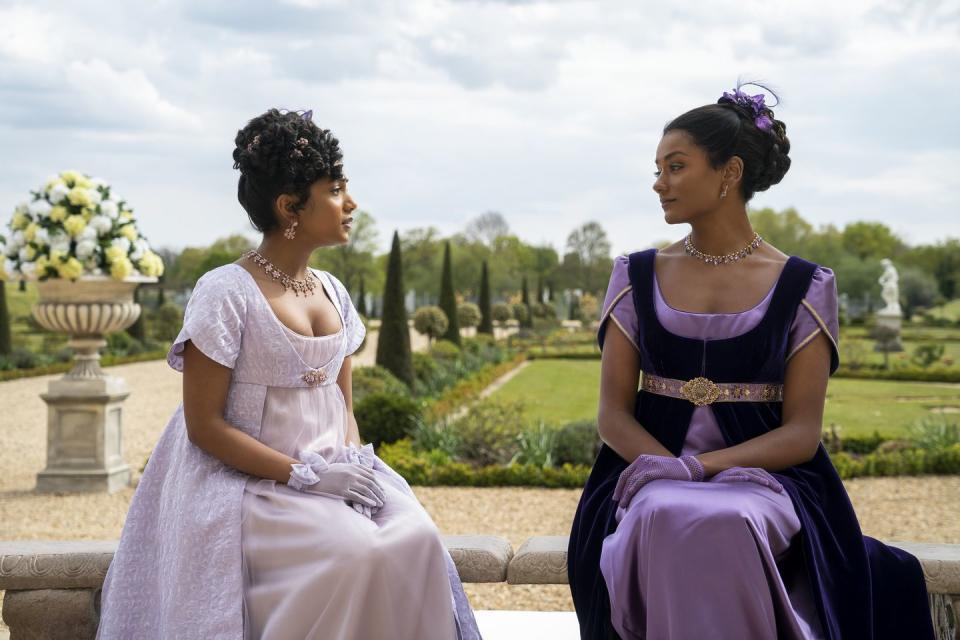
The Gilded Age takes us from the American West to the streets and parlors of New York City. It’s set in 1882, only 17 years removed from the end of the Civil War and five years after the federal government’s abandonment of Reconstruction and, in turn, the rights and safety of Black people who lived in the American South. The show, though a hit, has been criticized for not displaying enough of the actual cultural climate of the time and rather focusing on, well, the glitz and the gowns. Author Brandon Taylor wrote in a recent newsletter, “I watch the show because I love the gowns. I love the era. I love the idea of period dramas. I’m just unsure if American history can be squared to an inherently sentimental form. Especially at a time when American history is being whitewashed and papered over. … American history has always [been] an exercise in branding and spin.”
In the first episode, we meet Peggy Scott (Denée Benton), a young woman whose life takes a turn after an encounter on a train platform in Doylestown, Pennsylvania. She becomes our conduit to a type of Black character who is rarely seen in period dramas. “[W]hen we meet Peggy, we don’t want to reveal the whole story, so I started her quietly,” costume designer Kasia Walicka-Maimone tells BAZAAR.com. While many of the show’s white characters spend their time in a cloistered high-society world that feels familiar courtesy of Edith Wharton and Henry James, Peggy allows us to see parts of the city life that are rarely depicted on the page or screen.
“I wanted to create this sort of enigmatic persona where you cannot pinpoint where she’s from, and she moves elegantly through the world,” Walicka-Maimone says. “But that was also the function of the time: [T]here were all those events. There were tea parties. There were balls. There were morning dresses, evening dresses. We don’t portray Peggy in those scenarios. We portray her most of the time in day dresses. [It wasn’t] until we see her at the dinner at her household and at the light ceremony … when I used the bigger dresses knowing that she has those incredible dresses in her closet.”
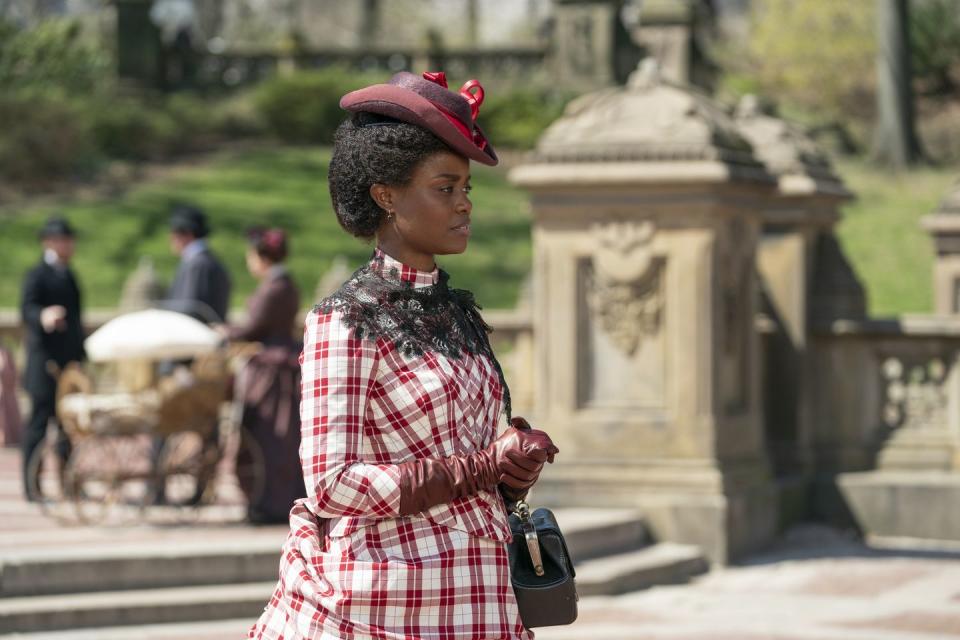
The audience eventually discovers that Peggy’s family is a part of New York’s Black elite. Because that group was relatively well documented at the time, Walicka-Maimone was able to find many resources to draw from. In fact, she notes that the “purple dress that she wears to [dinner at] her parents’ house … was taken straight from a photograph that we found from that period.”
But Walicka-Maimone adds that this is not a documentary. When you’re taking a character from script to screen, history and research can only take you so far. There’s a level of artistry involved in creating costumes, and for Walicka-Maimone, that came through in the colors. For the Scott household, Walicka-Maimone “stayed with the purples, olives, browns, golds, oranges,” but she also used color to define Peggy opposite Marian (Louisa Jacobson), a young white woman who has just entered New York’s high society (and whose introduction to this world allows the audience to tag along).
“Marian is pale yellow, comes from Pennsylvania, from meadows, from nature, from country, from innocence,” Walicka-Maimone says. “At the same time, I used brighter yellow on Peggy, just as a counterpart to the yellow of Marian, and I did it on purpose as a play between those two ladies who are more or less the same age, come from two very different backgrounds, very different environments, and they find common language with each other.”
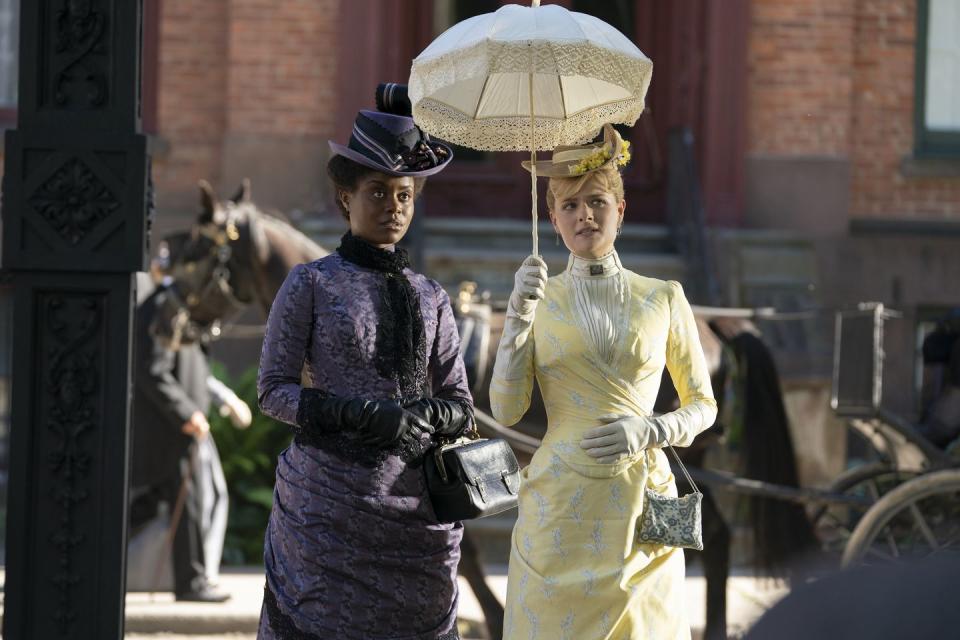
The Harder They Fall offers a different kind of period costume. The Western was a dominant force in Hollywood for decades, and it was in turn dominated by stories of white people who lived on the frontier. But the American West has always been diverse, from the Native population who already inhabited those lands, to the Chinese immigrants who were instrumental in the building of the railroads, to the Mexican population who were subsumed as the border of this nation pushed toward the Pacific. In The Harder They Fall, we get a look at the world of Black people who moved west in pursuit of freedom and riches via the conflict between two rivals: Nat Love (Jonathan Majors) and Rufus Buck (Idris Elba).
“I am a Jamaican Canadian, so I didn’t grow up in America, and I didn’t know that there were Black cowboys,” costume designer Antoinette Messam said in an interview with Harper’s BAZAAR UK last year. “Doing the research for this film, I saw that these people existed—these towns were real, their accomplishments were real, but you never saw them in the movies.” While many of the characters in the film are based on historical figures, director Jeymes Samuel took liberties with the storytelling, allowing Messam the freedom to play around with her designs. “At the end of the day, [Samuel] did not want to make a dusty old cowboy movie—he wanted it to look alive, he wanted it to have swagger, for it to be fun and funky.”

It helped that the film was set in a real-life hub of the fabric industry. “Redwood was a textile town. That was their base industry and that scene with the dye bins shows where the fabrics were done,” Messam said during an interview with Netflix’s Tudum. “It was important to show the industry because it explains that this was a town that was prosperous, that had business. They had their own mills, they manufactured their own fabrics. It was a statement of wealth and prosperity.”
That background informs the costumes of the Rufus Buck Gang, who are based in Redwood. Trudy Smith, played by Regina King, wears a dress in a deep, vibrant blue, while Buck himself draws your eye in one scene with a red velvet jacket. But there were pieces of the costuming that created a bridge between this gang and that of Nat Love, like the headscarves women like Trudy and Stagecoach Mary, played by Zazie Beetz, wear beneath their hats. “African Americans had natural hair, and it was easier and culturally correct to wrap their heads,” Messam said in the same interview. Those kinds of notes give us an understanding of the reality of Black people not only when they were dealing with the harsh elements of the film’s setting, but also now, throughout the world.
The characters in all three of these productions are, for the most part, fictional—and so are the clothes, in the sense that they’re not exact reproductions of historical dress. But audiences don’t turn to period dramas for museum-level accuracy; we watch them because they feel emotionally real, because they give us a sense of how life could have felt back then.
People of color have always inhabited all portions of society, whether or not they’ve been recognized by the white gaze, and they have always dressed in ways that reflect their status beyond just the color of their skin. Now that Hollywood is finally starting to reflect that fact, there’s no limit to the kinds of costumes we can see onscreen.
In a scene from The Gilded Age, Marian Brook shows up uninvited on the doorstep of the Scott family with a used pair of shoes that she plans to give them. The Scotts, of course, don’t need her used shoes: They’re perfectly capable of affording fine shoes of their own. It’s a pivotal moment, though, and it illustrates a broader truth. Peggy’s style of dress telegraphs her family’s social class, but Marian cannot see beyond her own prejudices of what it meant to be Black at that point in time. There’s a sartorial message here: The Scott family’s place within the world of Gilded Age New York City is far more complex than Marian’s limited world view can allow her to understand. It’s much like where we are within the world of film and television right now: reminding the masses that there’s simply more to our world and our histories than what we’ve been told.
You Might Also Like

